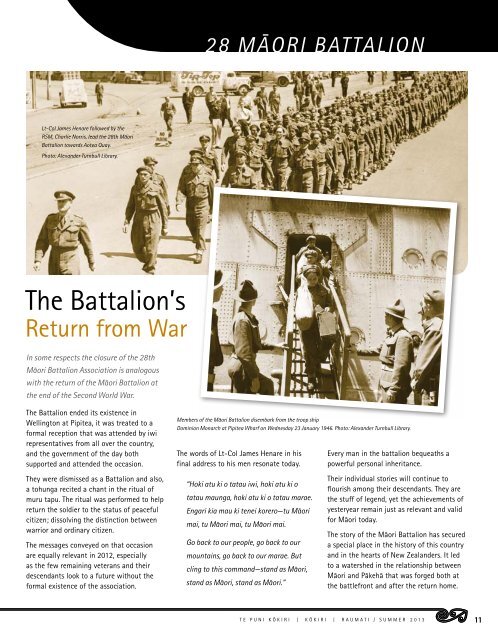Download the PDF (5.1MB) - Te Puni Kokiri
Download the PDF (5.1MB) - Te Puni Kokiri
Download the PDF (5.1MB) - Te Puni Kokiri
Create successful ePaper yourself
Turn your PDF publications into a flip-book with our unique Google optimized e-Paper software.
28 MÄORi BATTALION<br />
Lt-Col James Henare followed by <strong>the</strong><br />
RSM, Charlie Norris, lead <strong>the</strong> 28th Mäori<br />
Battalion towards Aotea Quay.<br />
Photo: Alexander Turnbull Library.<br />
The Battalion’s<br />
Return from War<br />
In some respects <strong>the</strong> closure of <strong>the</strong> 28th<br />
Mäori Battalion Association is analogous<br />
with <strong>the</strong> return of <strong>the</strong> Mäori Battalion at<br />
<strong>the</strong> end of <strong>the</strong> Second World War.<br />
The Battalion ended its existence in<br />
Wellington at Pipitea, it was treated to a<br />
formal reception that was attended by iwi<br />
representatives from all over <strong>the</strong> country,<br />
and <strong>the</strong> government of <strong>the</strong> day both<br />
supported and attended <strong>the</strong> occasion.<br />
Members of <strong>the</strong> Mäori Battalion disembark from <strong>the</strong> troop ship<br />
Dominion Monarch at Pipitea Wharf on Wednesday 23 January 1946. Photo: Alexander Turnbull Library.<br />
The words of Lt-Col James Henare in his<br />
final address to his men resonate today.<br />
Every man in <strong>the</strong> battalion bequeaths a<br />
powerful personal inheritance.<br />
They were dismissed as a Battalion and also,<br />
a tohunga recited a chant in <strong>the</strong> ritual of<br />
muru tapu. The ritual was performed to help<br />
return <strong>the</strong> soldier to <strong>the</strong> status of peaceful<br />
citizen; dissolving <strong>the</strong> distinction between<br />
warrior and ordinary citizen.<br />
The messages conveyed on that occasion<br />
are equally relevant in 2012, especially<br />
as <strong>the</strong> few remaining veterans and <strong>the</strong>ir<br />
descendants look to a future without <strong>the</strong><br />
formal existence of <strong>the</strong> association.<br />
“Hoki atu ki o tatau iwi, hoki atu ki o<br />
tatau maunga, hoki atu ki o tatau marae.<br />
Engari kia mau ki tenei korero—tu Mäori<br />
mai, tu Mäori mai, tu Mäori mai.<br />
Go back to our people, go back to our<br />
mountains, go back to our marae. But<br />
cling to this command—stand as Mäori,<br />
stand as Mäori, stand as Mäori.”<br />
Their individual stories will continue to<br />
flourish among <strong>the</strong>ir descendants. They are<br />
<strong>the</strong> stuff of legend, yet <strong>the</strong> achievements of<br />
yesteryear remain just as relevant and valid<br />
for Mäori today.<br />
The story of <strong>the</strong> Mäori Battalion has secured<br />
a special place in <strong>the</strong> history of this country<br />
and in <strong>the</strong> hearts of New Zealanders. It led<br />
to a watershed in <strong>the</strong> relationship between<br />
Mäori and Päkehä that was forged both at<br />
<strong>the</strong> battlefront and after <strong>the</strong> return home.<br />
T E P U N I K ö K I R I | K ö K I R I | R A U M A T I / S U M M E R 2 0 1 3<br />
11

















